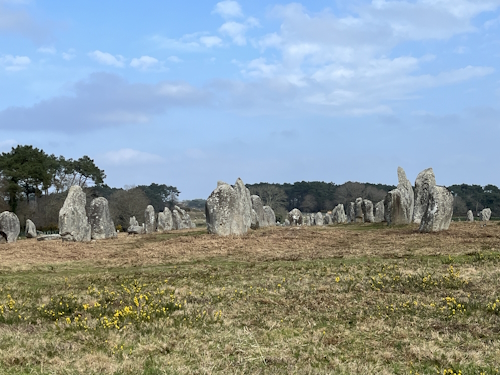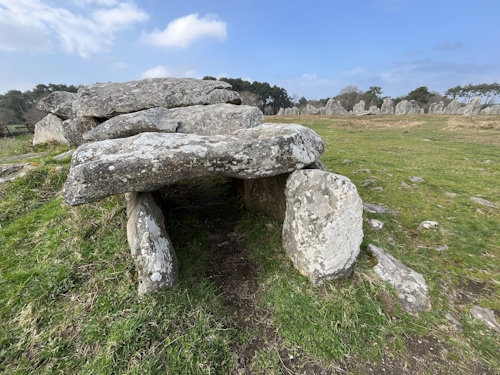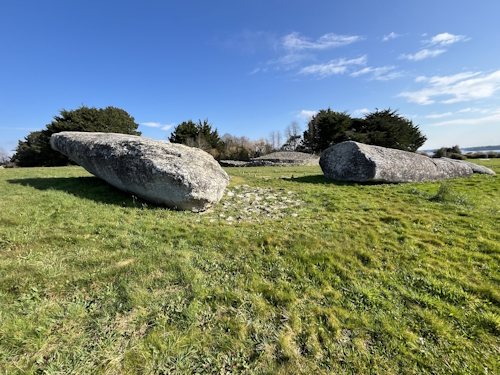Blog TWHS Visits
2025 WHC: Carnac
The 2025 WHC will probably bring us the inscription of number 31 on our Missing List: Carnac. Two other 2025 nominations, Neuschwanstein Castle and the Minoan Palaces, are even higher on that list, so it might become a good year. Carnac is on the Tentative List as ‘Megalithic Sites of Carnac’, but the nomination has been renamed ‘Carnac and Shores of the Morbihan megaliths’. It has been put forward as a Cultural landscape and comprises four components with thousands of standing stones and tombs. The TWHS has a 100% recommendation after 24 votes from our community.
Carnac is a representative of the European megalithic tradition since the Neolithic, which also includes the Megalithic Temples of Malta and multiple sites in the UK and Ireland, such as Stonehenge and Brú na Bóinne. While at other subjects we’ve now ended up at very niche Tier 3 sites, Carnac undoubtedly is at Tier 1 among its peers. The nominated area covers 19,598 ha, about 4x as large as Stonehenge/Avebury and 6x the sites in Malta. Its oldest parts significantly predate Stonehenge and overlap with the earliest timelines of Newgrange and Ħaġar Qim.
What took France so long to put this forward? Breton nationalists may claim it was subordination by “Paris”, but it just has been a long and careful process which has been described on the official nomination website. The story already starts in 1980, when Carnac was part of France’s first Tentative List (we had overlooked that; I’ve now updated the Site History accordingly). It stayed there until a revised list was submitted in 1984. It reappeared in 1996.
Along the way, things evolved:
- Although the sites have been popular tourist and scientific destinations since the 19th century, it took until the 1990s for them to be properly managed and protected. The Table des Marchands (a major dolmen at Locmariaquer) was only excavated and restored in the early 1990s for example.
- The scope changed from Carnac Alignments only in 1980 to multiple megalithic locations in the Morbihan area in the current proposal.
- In 2005, major excavations brought to light connections between the elements.
- In 2011, an Association was created to streamline the nomination process.
- Thanks to its size, many actors are involved so it is a slow process to keep them all on board. Some opposition from landowners has been reported in the past.
I started my visit at the Carnac Alignments component. Winter is a good time to visit as you’re allowed on the trail amidst the stones by yourself and there will be much less visitors overall. Entrance to the Alignments is also free from October-March. I was lucky with the weather in early March: sunny, blue skies. I parked at the Ménec alignments and then continued on foot. Nothing can prepare you for the first sight of the endless rows of neatly arranged standing stones. I walked most of the ‘Alignments trail’ that connects Ménec with the other Alignments. You can also go by car as all have (smallish) car parks.
The best part I found at the start of Kermario Alignment: it’s here that the standing stones get taller, a complete dolmen can be found (Photo 2) and you get the iconic views of the rolling hills covered with rows of stones. Unfortunately, late afternoon isn’t the best time of day for pictures from the viewing tower at the opposite end as it faces the sun. I also think that on-site interpretation could be more informative, although I understand that not much is known about the idea behind the Alignments. Here and there you still see markers left by people who oppose the fencing of the whole area.
Two days later, I went to the Locmariaquer component. As the crow flies, it lies only 8 km from the Alignments, though it is a bit further by road. The main part here is a cluster of three major monuments. A 7 EUR fee has to be paid to enter, but they let you watch a good video that provides a bit more context. The individual monuments (a 140m long tumulus, a dolmen and the grand fallen menhir) have information panels as well. The ruins of the Grand Menhir (Photo 3) – fallen and broken, possibly due to an earthquake - are the most impressive. Parts have been reused as spolia in the dolmen at the site, they have some simple carvings as well (plus a bit of historical graffiti, I think I read "Gazelle"?).
Els - 23 March 2025
Comments
Els Slots 23 March 2025
No, nothing official. Just how I perceive for example Koh Ker - a Tier 3 Khmer site (I wrote in my review: "But we are getting to the Tier 3 sites now I think, with Angkor solely occupying Tier 1 of the Khmer sites and the current WHS Sambor Prei Kuk and Preah Vihear holding Tier 2.").
It has more to do with "importance" than our rating system which is a bit of a mix of quality of the visit and intrinsic quality of the site.
Astraftis 23 March 2025
Are the tiers an official classification? 😬 Or maybe something we can determine from the site's statistics!


